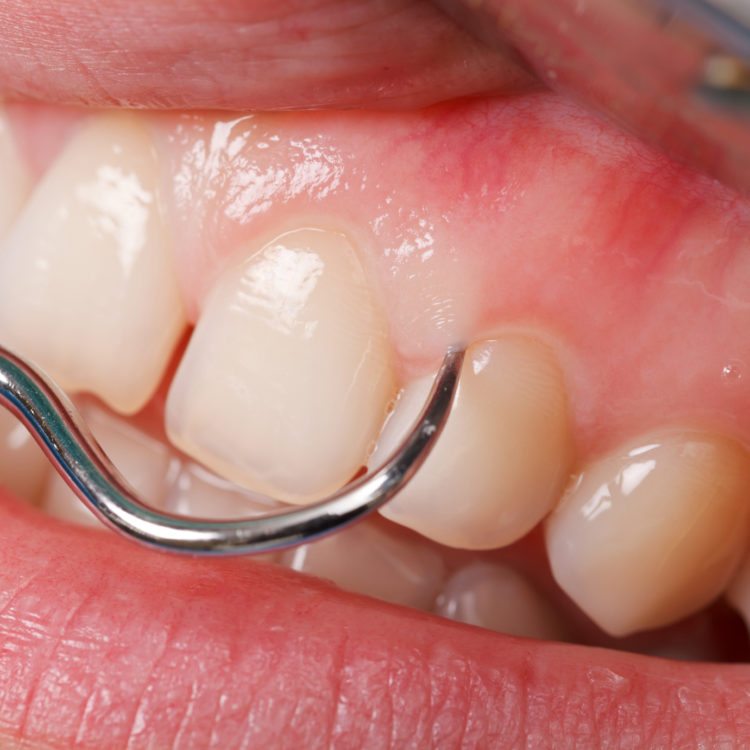IDENTIFYING AND MANAGING
Periodontics
Gum disease is usually caused by plaque, a sticky film of bacteria that constantly forms on teeth. If plaque is not removed with thorough daily brushing and cleaning between teeth, gums become irritated and inflamed. The irritated gum tissue can separate from the teeth and form spaces called pockets. Bacteria move into the pockets where they continue to promote irritation. Left untreated, the process can continue until the bone and other tooth-supporting tissues are destroyed. The early stage of periodontal disease is called gingivitis. It often results in gums that are red and swollen and may bleed easily.

Two Types of Gum Disease
Gingivitis
Gingivitis (gum inflammation) usually precedes periodontitis (gum disease). However, it is important to know that not all gingivitis progresses to periodontitis. In the early stage of gingivitis, bacteria in plaque build up, causing the gums to become inflamed and to easily bleed during tooth brushing. Although the gums may be irritated, the teeth are still firmly planted in their sockets. No irreversible bone or other tissue damage has occurred at this stage.
When gingivitis is left untreated, it can advance to periodontitis. In a person with periodontitis, the inner layer of the gum and bone pull away from the teeth and form pockets. These small spaces between teeth and gums collect debris and can become infected. The body’s immune system fights the bacteria as the plaque spreads and grows below the gum line.
Toxins or poisons – produced by the bacteria in plaque as well as the body’s “good” enzymes involved in fighting infections – start to break down the bone and connective tissue that hold teeth in place. As the disease progresses, the pockets deepen and more gum tissue and bone are destroyed. When this happens, teeth are no longer anchored in place, they become loose, and tooth loss occurs. Gum disease is the leading cause of tooth loss in adults.
Periodontitis
Periodontitis means “inflammation around the tooth.” It is a serious gum infection that damages the soft tissue and bone that supports the tooth. All periodontal diseases, including periodontitis, are infections, which affect the periodontium – supporting tissues around a tooth. With periodontitis, the alveolar bone around the teeth is slowly and progressively lost. Microorganisms, such as bacteria, stick to the surface of the tooth and multiply – an overactive immune system reacts with inflammation.
Untreated, periodontitis will eventually result in tooth loss, and may increase the risk of stroke, heart attack and other health problems. Bacterial plaque, a sticky, colorless membrane that develops over the surface of teeth, is the most common cause of periodontal disease. In dentistry, periodontics deals with the prevention, diagnosis and treatment of diseases involving the gums and structures, which support teeth. In most cases, periodontitis is preventable. It is usually caused by poor dental hygiene.
Prevention and Treatment
Preventing periodontitis involves knowing the risk factors. The following risk factors are linked to a higher risk of periodontitis:
-
Smoking – regular smokers are much more likely to develop gum problems. Smoking also undermines the efficacy of treatments.
-
Hormonal changes in females – puberty, pregnancy, and the menopause are moments in life when a female’s hormones undergo changes. Such changes raise the risk of developing gum diseases.
-
Diabetes – patients who live with diabetes have a much higher incidence of gum disease than other individuals of the same age.
-
AIDS – people with AIDS have more gum diseases.
-
Cancer – cancer, and some cancer treatments can make gum diseases more of a problem.
-
Some drugs – some medications that reduce saliva are linked to gum disease risk.
-
Genetics – some people are more genetically susceptible to gum diseases.
One of the most effective ways to treat gum disease is periodontal scaling and root planing. Periodontal scaling is a type of cleaning that removes plaque and calculus from the teeth at and slightly below the gum line. “Root planing” smooths the root surface, so the supportive tissue can better re-attach to the tooth surface. For this procedure, a local anesthetic may be utilized. We may also prescribe an antibacterial mouth rinse to help control bacterial levels and improve healing. If conventional therapy is not successful, you may be a candidate for a more advanced dental procedure and possibly referral to a periodontal specialist.


